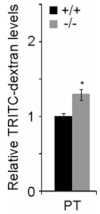The Myc 3' Wnt responsive element regulates neutrophil recruitment after acute colonic injury in mice
- PMID: 23640071
- PMCID: PMC4104363
- DOI: 10.1007/s10620-013-2686-x
The Myc 3' Wnt responsive element regulates neutrophil recruitment after acute colonic injury in mice
Abstract
Background: The Wnt/β-catenin pathway regulates intestinal development, homeostasis, and regeneration after injury. Wnt/β-catenin signaling drives intestinal proliferation by activating expression of the c-Myc proto-oncogene (Myc) through the Myc 3' Wnt responsive DNA element (Myc 3' WRE). In a previous study, we found that deletion of the Myc 3' WRE in mice caused increased MYC expression and increased cellular proliferation in the colon. When damaged by dextran sodium sulfate (DSS), the increased proliferative capacity of Myc 3' WRE(-/-) colonocytes resulted in a more rapid recovery compared with wild-type (WT) mice. In that study, we did not examine involvement of the immune system in colonic regeneration.
Purpose: To characterize the innate immune response in Myc 3' WRE(-/-) and WT mice during and after DSS-induced colonic injury.
Methods: Mice were fed 2.5 % DSS in their drinking water for five days to induce colonic damage and were then returned to normal water for two or four days to recover. Colonic sections were prepared and neutrophils and macrophages were analyzed by immunohistochemistry. Cytokine and chemokine levels were analyzed by probing a cytokine array with colonic lysates.
Results: In comparison with WT mice, there was enhanced leukocyte infiltration into the colonic mucosal and submucosal layers of Myc 3' WRE(-/-) mice after DSS damage. Levels of activated neutrophils were substantially increased in damaged Myc 3' WRE(-/-) colons as were levels of the neutrophil chemoattractants C5/C5a, CXCL1, and CXCL2.
Conclusion: The Myc 3' WRE regulates neutrophil infiltration into DSS-damaged colons.
Figures








Similar articles
-
The myc 3' wnt-responsive element suppresses colonic tumorigenesis.Mol Cell Biol. 2014 May;34(9):1659-69. doi: 10.1128/MCB.00969-13. Epub 2014 Feb 24. Mol Cell Biol. 2014. PMID: 24567369 Free PMC article.
-
A Role for MYC in Lithium-Stimulated Repair of the Colonic Epithelium After DSS-Induced Damage in Mice.Dig Dis Sci. 2016 Feb;61(2):410-22. doi: 10.1007/s10620-015-3852-0. Epub 2015 Aug 30. Dig Dis Sci. 2016. PMID: 26320084
-
The Myc 3' Wnt-responsive element regulates homeostasis and regeneration in the mouse intestinal tract.Mol Cell Biol. 2012 Oct;32(19):3891-902. doi: 10.1128/MCB.00548-12. Epub 2012 Jul 23. Mol Cell Biol. 2012. PMID: 22826434 Free PMC article.
-
Turning the tables: Myc activates Wnt in breast cancer.Cell Cycle. 2007 Nov 1;6(21):2625-7. doi: 10.4161/cc.6.21.4880. Epub 2007 Aug 13. Cell Cycle. 2007. PMID: 17726380 Review.
-
Advances in neutrophil biology: clinical implications.Chest. 2008 Sep;134(3):606-612. doi: 10.1378/chest.08-0422. Chest. 2008. PMID: 18779195 Free PMC article. Review.
Cited by
-
The myc 3' wnt-responsive element suppresses colonic tumorigenesis.Mol Cell Biol. 2014 May;34(9):1659-69. doi: 10.1128/MCB.00969-13. Epub 2014 Feb 24. Mol Cell Biol. 2014. PMID: 24567369 Free PMC article.
-
The Crohn's disease associated SNP rs6651252 impacts MYC gene expression in human colonic epithelial cells.PLoS One. 2019 Feb 22;14(2):e0212850. doi: 10.1371/journal.pone.0212850. eCollection 2019. PLoS One. 2019. PMID: 30794691 Free PMC article.
-
A Role for MYC in Lithium-Stimulated Repair of the Colonic Epithelium After DSS-Induced Damage in Mice.Dig Dis Sci. 2016 Feb;61(2):410-22. doi: 10.1007/s10620-015-3852-0. Epub 2015 Aug 30. Dig Dis Sci. 2016. PMID: 26320084
-
High Cannabigerol Hemp Extract Moderates Colitis and Modulates the Microbiome in an Inflammatory Bowel Disease Model.J Pharmacol Exp Ther. 2024 Aug 19;390(3):331-341. doi: 10.1124/jpet.124.002204. J Pharmacol Exp Ther. 2024. PMID: 39009468 Free PMC article.
References
-
- Clevers H, Nusse R. Wnt/beta-catenin signaling and disease. Cell. 2012;149:1192–1205. - PubMed
-
- Simons BD, Clevers H. Stem cell self-renewal in intestinal crypt. Exp Cell Res. 2011;317:2719–2724. - PubMed
-
- Fukui T, Takeda H, Shu HJ, et al. Investigation of Musashi-1 expressing cells in the murine model of dextran sodium sulfate-induced colitis. Dig Dis Sci. 2006;51:1260–1268. - PubMed
Publication types
MeSH terms
Substances
Grants and funding
LinkOut - more resources
Full Text Sources
Other Literature Sources
Medical
Molecular Biology Databases
Miscellaneous

